How to Grow and Care for Wallflower Plants
Wallflowers are colorful, fragrant, and easy-to-grow
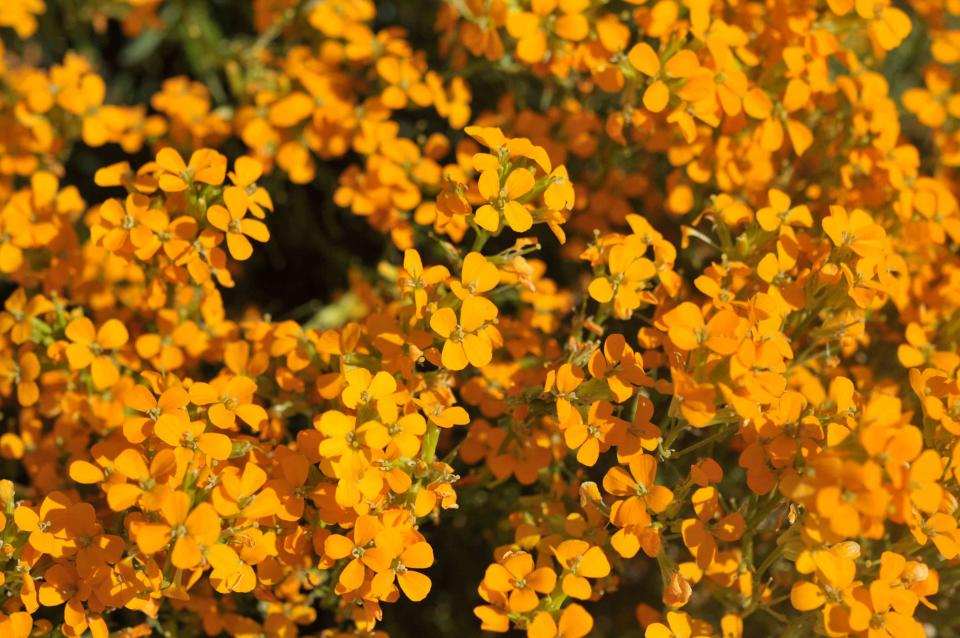
The Spruce / Evgeniya Vlasova
Wallflower is considered a shrub or groundcover that sprouts pretty blossoms through silty cracks in brick or cement walls, which is how it gets its name. Wallflower grows best in warmer climates and very well-draining soil that dries somewhat quickly. The plant can tolerate soil that is very alkaline.
Common Name | Wallflower |
Botanical Names | Erysimum cheiri, Erysimum linifolium |
Family | Brassicaceae |
Plant Type | Perennial, annual, biennial, herbaceous |
Mature Size | 1-3 ft. tall, 2-4 ft. wide |
Sun Exposure | Full, partial |
Soil Type | Sandy, well-drained |
Soil pH | Neutral, alkaline |
Bloom Time | Spring, summer, fall |
Flower Color | Yellow, orange, purple, pink, blue, red |
Hardiness Zones | 6-10 (USDA) |
Native Area | Europe |
Wallflower Care
Here are the main care requirements for growing wallflowers.
Plant wallflowers in a sunny position.
Use well-draining soil that's somewhat gritty with sand or small rocks.
Do not plant in wet, soggy, or poorly draining areas.
Space the plants about 10 to 12 inches apart in the ground.
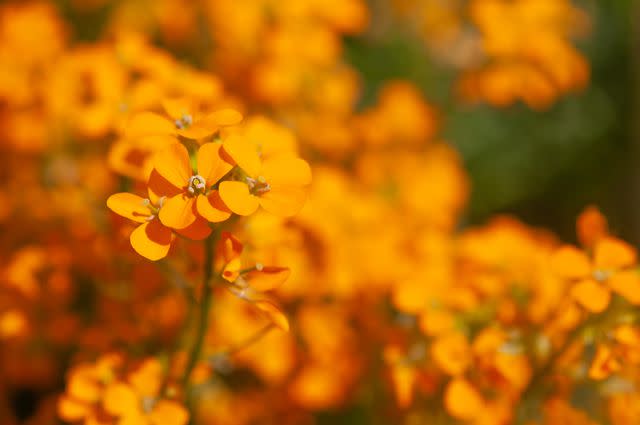
The Spruce / Evgeniya Vlasova
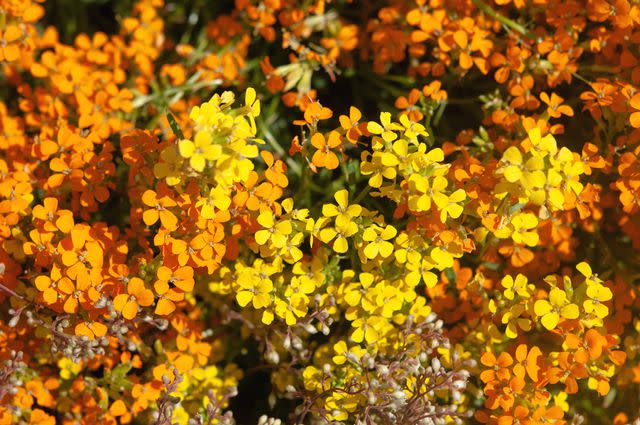
The Spruce / Evgeniya Vlasova
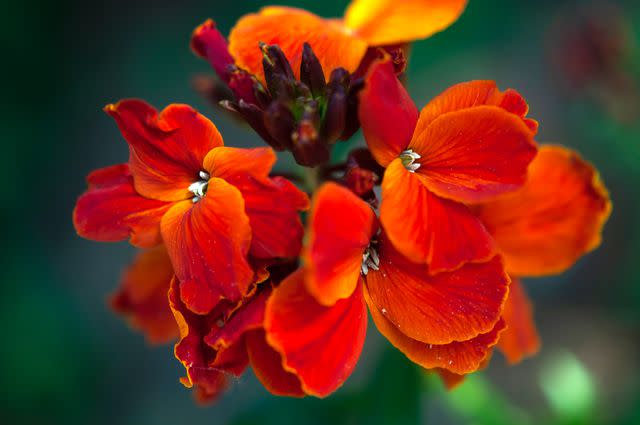
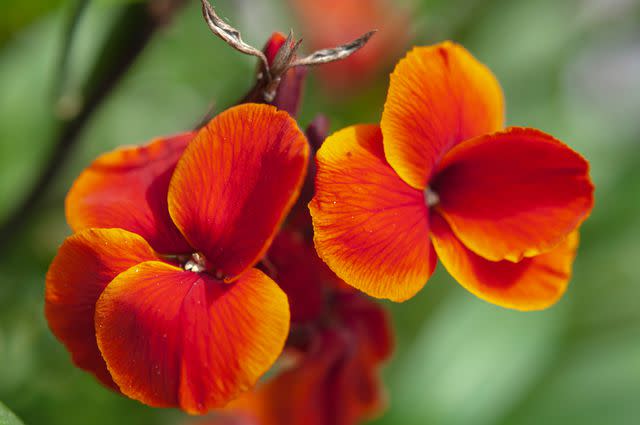
The Spruce / Evgeniya Vlasova
Light
Wallflowers should be grown in a bright, sunny location. While they can tolerate part shade they will thrive in full sun. Gardeners in northern climates should choose locations that receive direct sun, whereas gardeners in southern climates should plant in places that receive some afternoon shade.
Soil
Well-drained, dry to medium-dry soils are ideal for wallflower. Wallflowers do not tolerate wet feet, or having their roots sit in standing water, so avoid planting wallflowers in particularly wet areas of your garden or in poorly draining soil, which leads to rapid decline and plant death. Wallflowers can grow in very alkaline soils (pH 7.0 to 9.0).
Water
Wallflowers are considered drought-tolerant, and as such, they do not require too much water. Only water wallflowers regularly as they are becoming established, and then cut back once they have matured.
Temperature and Humidity
In warm climates (USDA zones 8 to 10) perennial wallflower varieties grow as evergreens. At the lower end of their hardiness range, they can still be grown as a perennials but their foliage will likely die back in the winter. Below their hardiness range, wallflower is usually grown as an annual.
Fertilizer
Wallflowers do not require a lot of fertilizer to thrive, in fact, fertilization is generally not recommended.. Instead, mix compost into the soil when you are first planting.
Types of Wallflowers
Most wallflowers are cultivars or hybrids. Notable varieties include:
E. cheiri 'Sunset Apricot', a biennial with fragrant, yellow-apricot flowers
E. cheiri ' 'Sunset Primrose', an evergreen perennial with flowers that start lemon yellow and turn primrose as they age
'Winter Passion' and 'Winter Orchid' belong to the trademarked 'Winter' series of compact and mounding perennial hybrids with large, fragrant flower spikes.
'Red Jep', a hybrid with fragrant red to purple flowers
E. linifolium 'Bowles’s Mauve' with rich, mauve blooms
'Walberton’s Fragrant Sunshine', a trademarked hybrid with compact, bushy orange blooms
Pruning
Deadheading is important for keeping wallflowers healthy and full looking. To encourage ongoing blooming, pinch back spent blooms regularly. Once the plants have finished blooming, or in the early spring in warm climates, prune the stems back at least half to prevent them from getting leggy. In cooler climates, prune them in the fall so there is only a couple of inches left above the soil, and they will reward you with dense new growth once temperatures warm up again.
Propagating Wallflowers
Before you set out to propagate a wallflower, check whether the variety is trademarked or protected by a plant patent, as the propagation of those plants is prohibited. If that's not the case, wallflowers that are grown as biennials or perennials can be propagated through cuttings in the late spring.
With a sterilized, sharp knife or pruner, take a cutting that has at least one leaf node.
Remove all flowers and flower buds from the cutting and leave only three to four leaves.
Dip the cutting in a rooting hormone and insert it in 4-inch pots filled with potting mix.
Water it well and keep it evenly moist until new growth appears.
When the cutting does not move when you gently tug on it, it's ready to be transplanted into garden soil or a larger container for a patio or deck.
Growing Wallflowers from Seed
To grow wallflowers from seed, sow the seeds directly into the garden or start them indoors 10 to 12 weeks before the last frost in your area. In locations with warm winters (USDA zone 8 to 10) you can also start the seeds in the late autumn.
The seeds require light to germinate so don't cover them with more than 1/8 of an inch of soil. Make sure to provide adequate light for germination.
Wallflowers transplant well once established.
Potting and Repotting Wallflowers
Shrub-type wallflowers make excellent container plants as they are low maintenance and don’t require too much water. Choose a container that is large enough to accommodate the root system plus about 6 inches. Ensure your container has adequate drainage as wallflowers do not tolerate having their roots sit in water. Choose a well-draining potting soil.
Repot the plant when its roots fill the container, or grow out of the drainage holes.
Overwintering
When grown in its hardiness range, wallflower does not need any winter protection although it might drop its leaves at the cooler end of the hardiness range.
Outside of its hardiness range, it is best to grow wallflower as an annual. While you can bring a potted plant indoors for the winter, it might get leggy if you don't have a spot in a bright, south-facing window, or add supplemental grow lights.
Common Pests & Plant Diseases
As a part of the Brassicaceae family, wallflowers are susceptible to a host of common garden pests just like their vegetable cousins. These include flea beetles, aphids, and cabbage worms. However, wallflowers are better suited to dry growing conditions than their Brassicaceae relatives, which inadvertently helps to prevent pest infestations. Another way to prevent infestations and diseases in wallflowers is to ensure that you are not planting wallflowers in a garden bed or container that has recently grown other Brassicaceae species as pathogens may remain in the soil from the previous plant.
How to Get Wallflowers to Bloom
Bloom Months
How Long Does Wallflower Bloom?
What Does Wallflower Look and Smell Like?
Wallflowers are beautiful four-petalled blooms that come in yellow, orange, red, blue, and purple. Wallflowers are sweetly scented. They make great shrubs, ground covers, and are great additions to any rock garden, border, or container garden.
How to Encourage More Blooms
Caring for Wallflower After It Blooms
If you live in a warm climate, trim it back to about half and deadhead it (unless you would like it to reseed itself). In a climate where it won't survive the winter and wallflower is usually grown as an annual, the end of the bloom also means the end of the plant's life cycle so you should discard it.
Common Problems With Wallflower
Wallflower plants are generally easy to grow and low-maintenance. Here are some tips to consider if you notice that the plant is behaving differently than you are used to.
Not Blooming
If you propagated your own plant, depending on when you started it, the wallflower might not bloom during the first year. A plant purchased from a nursery, on the other hand, should bloom the first year. If it doesn't, it is most likely due to lack of sun, as wallflower needs full sun to bloom at its best.
Becoming Leggy
Frequently Asked Questions
Is wallflower a perennial?
That depends on where you are located. Clearly, they are determined, hardy blooms. In warm climates, they bloom nearly year-round and can be grown as a short-term perennial or biennial. In cooler climates, they are mostly grown as annuals.
Is wallflower invasive?
Wallflowers are not considered invasive. Although they self-seed, you can easily remove unwanted seedlings.
Is there a wallflower native to North America?
The Western wallflower (Erysimum capitatum) is native to North America. It is also known as the sanddune wallflower or prairie rocket.
Read the original article on The Spruce.

